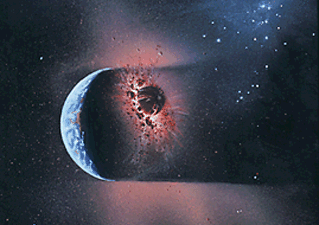Journey to the Center of the Moon
Jan. 3, 2012
Did Earth once have two moons? Does the moon have an iron core? Where should astronauts or unpiloted probes land for future missions to the moon? Information gathered by two new NASA probes orbiting Earth’s single natural satellite may soon help scientists answer these questions and several more. Launched on Sept. 10, 2011, the twin spacecraft of the GRAIL mission (Gravity Recovery and Interior Laboratory) went into orbit around the moon on December 31, and Jan. 1, 2012. Their mission is to create the most detailed map of the moon’s gravitational field ever made.
GRAIL-A and GRAIL-B were to spend the next two months gradually orbiting closer and closer to the surface until they are flying in formation at an altitude of only about 34 miles (55 kilometers). Then in March, instruments on-board the probes will start measuring the distance between them to within a few microns–the width of a human blood cell. That distance will vary as differences in the gravitation field caused by mountains, craters, and other surface features as well as features belowground cause the probes to speed up or slow down slightly. The probes will then radio this information to scientists at the Jet Propulsion Laboratory in Pasadena, California.

A tremendous collision between Earth and a smaller object led to the birth of the moon. Debris from the impact went into orbit in a ring around Earth, then gathered together to form the moon. © William K. Hartmann
The second-moon theory is one explanation for the startling differences between the smoother near side and higher, more-mountainous far side of the moon. Scientists believe that the moon formed as a result of a collision 4.6 billion years ago between Earth and an object roughly the size of the planet Mars. Vaporized rock from Earth’s surface blasted into orbit around Earth then gradually cooled into solid bodies that gathered together. Some scientists believe that a second, much-smaller moon formed at the same time. They have theorized that after 10 million to 100 million years, the smaller moon collided with its larger companion. During the impact, the smaller moon flattened itself against the far side of the moon, creating the elevated highlands there. The gravitational map should show evidence of this impact, if it occurred, along with the answers to many other questions.
Additional World Book articles
- Armstrong, Neil
- Galileo (Mature scientific career)
- How the Moon Was Born (A Special Report)
- Space exploration (Lunar probes)


